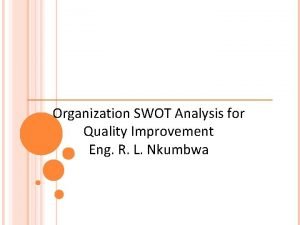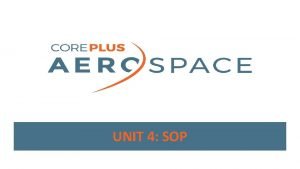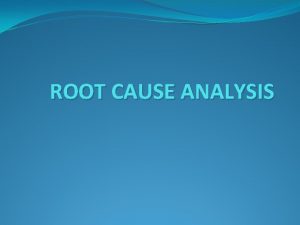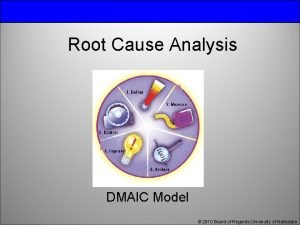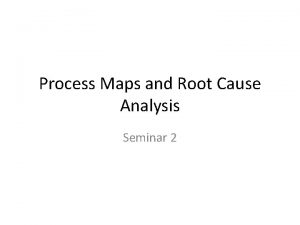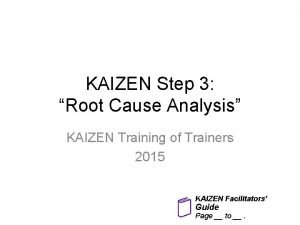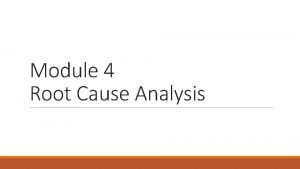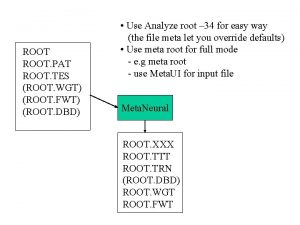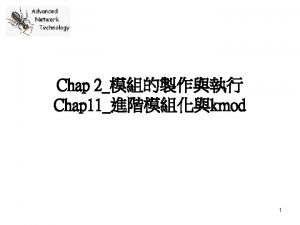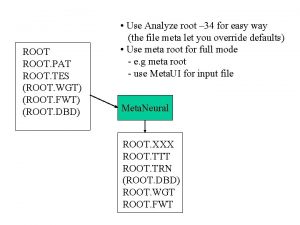Root Cause Analysis as a Quality Improvement Tool







- Slides: 7

Root Cause Analysis as a Quality Improvement Tool for Identifying Barriers to Retention in HIV Care in Uganda Willy Bikokye Kafeero CDC Uganda July 7, 2020 Willy Bikokye Kafeero 1, B. Elur 1, D. Bogere 1, S. Sendagala 1, J. Ssendiwala 1, P. Namukanja 1, A. Namale 1, J. Calnan 2, A. C. Awor 1, J. Ward 1 1 Centers for Disease Control and Prevention (CDC) Uganda 2 United States Agency for International Development (USAID) Uganda

BACKGROUND: UGANDA IS CLOSING IN ON 90 -90 -90 TARGETS • Uganda is approaching the UNAIDS 90 -90 -90 targets with 84% of PLHIV knowing their HIV status, 87% on ART and 88% virally suppressed (UNAIDS 2018). • Addressing gaps in retention and viral suppression are critical to sustain program gains made and achieve the 95 -95 -95 UNAIDS targets by 2030 for epidemic control. • Continuous quality improvement (CQI) efforts to close the quality gaps in the HIV/AIDS treatment cascade, and retention in particular, will be described. Progress Towards 90 -90 -90 Target Source: UNAIDS, 2018

IMPLEMENTING ROOT CAUSE ANALYSIS (RCA) TO TRACE CLIENTS LOST TO FOLLOW-UP (LTFU) • As of December 2018, Uganda reported 1, 004, 162 PLHIV receiving ART services. • Between Oct-Dec 2018, 36, 702 patients were reported as lost to follow-up (LTFU) • Cross sectional at 152 sites with high numbers (80%) of missed appointments in 56 district • Structured interviews of 36, 702 reachable clients that had missed their clinical appointments at health facility community or setting (responses were given by caregivers in case of children). Question: What was the main reason for missing your appointment at the health facility? • Analysis: Tally and frequency tabulation of client responses. Pareto Analysis used to determine the root causes by applying the 80: 20 rule.

800 600 500 300 200 100 950 900 758 700 80% Cut off (80: 20 Rule) 242 205 192 162 159 134 110 98 77 63 56 53 39 34 33 26 24 19 18 17 14 12 11 11 10 70% 579 60% 476 417 50% 400 40% 30% 20% 9 0 10% 0% Cumulative % 1000 Lack of transport/ long Distance Forgot appointment Had Travelled Was Sick Busy at work /Training Attend Burrial Stigma Changed Residence Attending to a sick relative Pill balances/ Still had drugs Self transferred/soldier transferred Non disclosure Long Waiting Time Active but not documented Staffs not around/ Came late Child at School Imprisoned Doesnot want ART/drug holiday Mistreatment from H/worker / demand of money from medical Personal / Family workers Issues/separated Drug Abuse/Alcoholic lack of food GBV(Husband) Drug Side effects Had visitors at home Had given Birth No reason Heavy rain on appointment date Tested HIV negative/ Doubt my HIV status Phone off Joined Church/ Praying for healing Frequency # KEY FINDINGS 100% 90% 80%

CONCLUSION & LESSONS LEARNED Conclusion • Large scale implementation RCA is feasible and useful in identifying gaps in service quality that impact programming. For retention, while roll out of differentiated service delivery may address transport challenges, further analysis is required to determine best solutions Results • Of the 36, 702 patients initially categorized as LTFU, 5, 008 were traced by community peers or reached on phone by facility staff; 95% (4, 758) were >15 years, 60% (3, 005) females. • From the RCA, of those LTFU were a result of lost clients reported lack of transport or long distance, 19% (950), forgot appointment; 15% (758) while travel away from home, sickness, or work accounted for 12%, 10% and 8. 3% respectively. • We have used the findings to introduce multi- month drug refills to support stable clients and plan well with their drug refills as well as supporting those with both planned and emergency travel to reduce drug stockouts

ACKNOWLEDGEMENTS • • • All CDC and USAID Technical Staff Above-Site Implementing partners CDC –METS and USAID –SITES All CDC and USAID supported Implementing partners AIDS Control Program / Mo. H – Uganda Staff Districts and Health Facilities Staff

Thank You! The findings and conclusions in this report are those of the authors and do not necessarily represent the official position of the Centers for Disease Control and Prevention. For more information, contact: mex 5@cdc. gov


